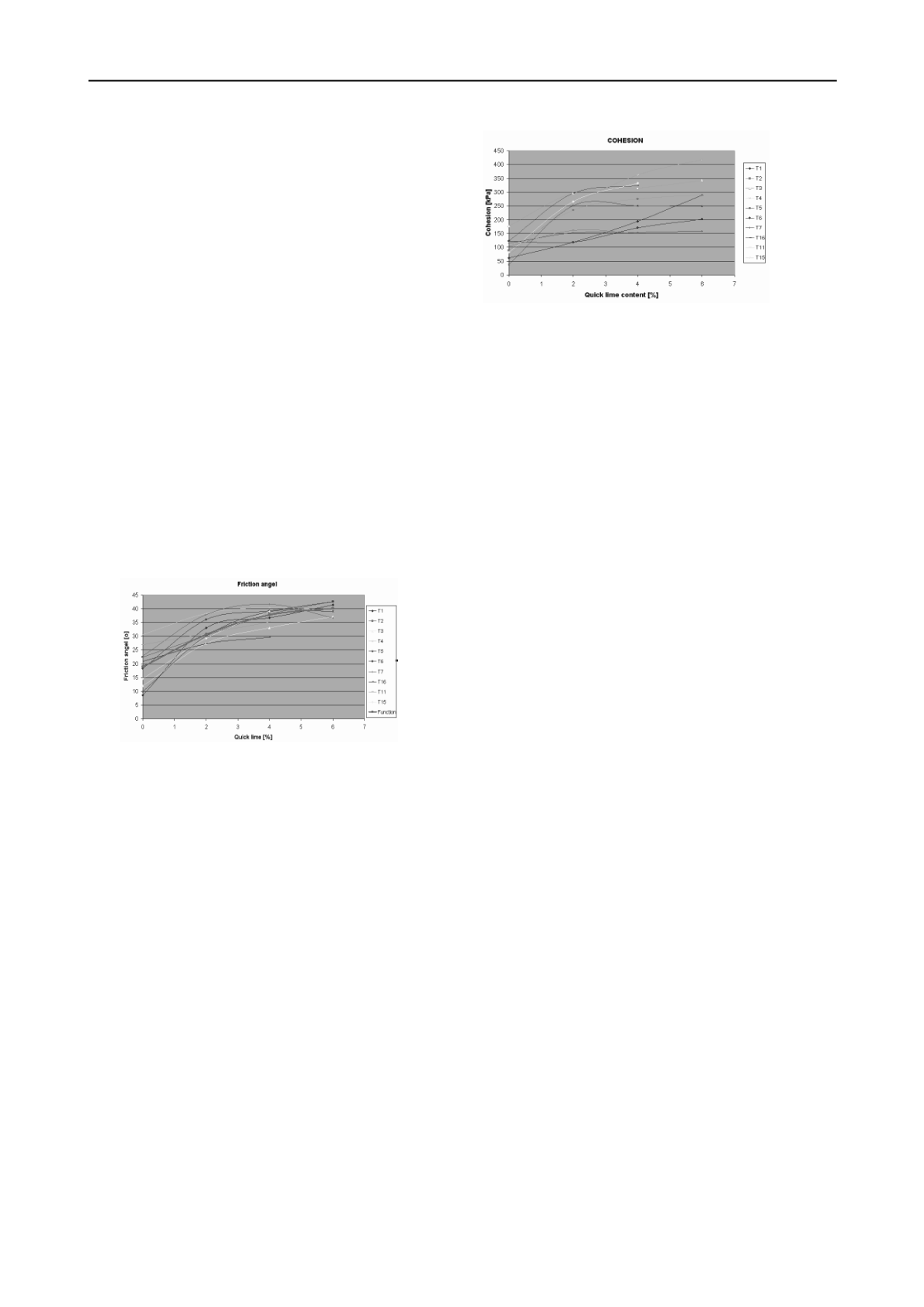
2604
Proceedings of the 18
th
International Conference on Soil Mechanics and Geotechnical Engineering, Paris 2013
5 ALTERATION OF THE LOAD BEARING CAPACITY
OF THE SOIL
Drying and working in soils are facilitated by the addition of
lime which is very important to constructers. Therewith the
important to designers is an intensive increase of the load
bearing capacity based on the effect of lime exerted on the soil
structure. The load bearing capacity of soils is determined by
their parameters related to shearing strength and deformation.
4.3.
Alteration of the parameters related to shearing strength
In order to define the internal friction angle
(Ф)
and the
cohesion (c), I have performed triaxial compression test over a
long range of the above mentioned soils. Similarly to the
previous procedures added lime was 2 %, 4 %, and 6 %, the
temporal aspect has been investigated in ages of 1, 7, and 31
days.
The evaluation of the measurement results shows a growth
of the values of friction angle and cohesion. At the 1 day old
samples the growth showed a fully disordered picture, then the
alteration of value
„Ф”
shift towards a single zone as the
boundaries of consistency at the age of 31 days. In case of
admixing an ideal quantity of lime, the soils are shifting towards
the value of
Ф=40
o
. A growth can also be measured at lower
lime quantities, however its extent does not reach the value of
40
o
that can be regarded as maximum, while the addition of an
excessive lime quantity results in a stagnation or decrease. The
curve fitted to the measurement results is visualized in Figure 5.
Figure 5. Increase of the friction angle at an age of 28 days, plotted
against the quantity of lime
The equation of the fitted curve based on 10 different soil
can be expressed with the following function:
9,18
07,7
589 ,0
2
M M
(1)
where
Ф
- internal friction angle
M - added lime quantity
With the use of the function, the fitting to the points could be
expressed with the value of R
2
=0.77.
The function does not work at M=0% and it is limited to
M=8%, which is the rationality quantity of added quick lime.
The extent of growth of the cohesion did not show a
consistency similar to the previous one. The improvement
amounted generally to several hundreds of per cent, with 150 %
experienced in the worst case (Figure 6).
The above demonstrated alterations of the shearing
parameters have been measured at an age of 28 days, when only
the impact of the cation exchange prevailed to a significant
extent among the chemical processes taking place during
stabilization.
Further alterations triggered by the puzzolan reaction have
been tested on a sample taken at an age of 15 months.
According to the results of measurement, no changes could be
experienced at the friction angle of the stabilization, it
maintained its value of
Ф=40
o
, however the value of the
cohesion increased to c = 787 kPa, from the value of
c = 343 kPa measured at an age of 28 days. The alteration of the
shearing parameters clearly demonstrates the cementation effect
of the puzzolan reaction.
Figure 6. Increase of the cohesion at an age of 28 days, plotted against
lime quantity
6 CONCLUSIONS
During a soil stabilization with lime, the Ca
2+
ions introduced
into the soil attach to the surface of the clay particles, replacing
the cations located there previously. Due to the high charging of
the Ca
2+
ions, the clay particles coagulate. The coagulation
exerts a decisive effect on the soil structure, resulting the
plasticity index in a shifting towards a certain zone. This effect
leads to the elimination of the silt and clay particles, resulting in
an intensive reduction surface of the particle of the
stabilizations.
Due to the coagulating particles, the friction angle increases,
and also the value of cohesion becomes higher. The addition of
lime results consequently in a growth of the compression
strength of the soil, leading to an increased load bearing
capacity.
Contrary to the literature, I regard to remark that the positive
impacts of lime stabilization of the soil is basically a result of
the cation exchange, while the puzzolan reaction playing only a
secondary role.
It is also important to remark that the lime stabilization of
soils is not only suitable for the drying up of soaked soils. With
the application of a planned and properly executed stabilization,
load bearing capacity of ballast materials can be achieved with
local soils regarded or qualified as unsuitable. Accordingly, the
ballast and pavement layers can be effectively reduced, and the
quantity of delivered external materials minimized.
7 REFERENCES
Boromissza T. 1999. Hungarian design rules of concrete pavements.
Közlekedési és mélyépítési szemle (évfolyam, szám, oldalak) (in
Hungarian)
Bowles XXX:
Engineering Properties of Soils and their Measurement
Filep Gy. 1988.
Chemistry of soils
. Akadémiai kiadó, Budapest
Jan M. A., Walker R. D. 1963. Effect of Lime, Moisture and
Compaction on a Clay Soil.
Highway Research Record
29, 1-12.
Kézdi Á. 1967.
Stabilized earthroads
. Akadémiai Kiadó, Budapest
Little D.N. 1999:
Evaluation of Structural Contribution of Lime
Stabilized Soils and Aggregates, Summary of Findings
, 1999
National Lime Association
Lohmeyer G., Ebeling K. 2001.
Building of industrial floors
. Magyar
Építőanyagipari Szövetség Építésügyi (in Hungarian)
Mitchell J.K., Hooper D.R. 1961. Influence of Time Between Mixing
and Compaction on Properties of a Lime-Stabilized Expansive
Clay,
Highway research Board
304, 14-31.
Nemesdy E. 1983.
Building technology of road pavements
.
Tankönyvkiadó, Budapest (in Hungarian)
Szendefy J. 2008. Impact of soilstabilization with lime to the structure
and bearing capacity of internal soils,
Geotechnic conference,
Ráckeve (in Hungarian)
ÚT 2-1-222-
2002, Útügyi Műszaki Előírás:General Rules of
Geotechnical Design of Roads (in Hungarian)
Wang J. W. H. 1963. Comparative Studies on the Effects of Hydraulic,
Calcitic and Dolomitic Limes and Cement in Soil Stabilization,
Highway Research Record
29, 42-54.


